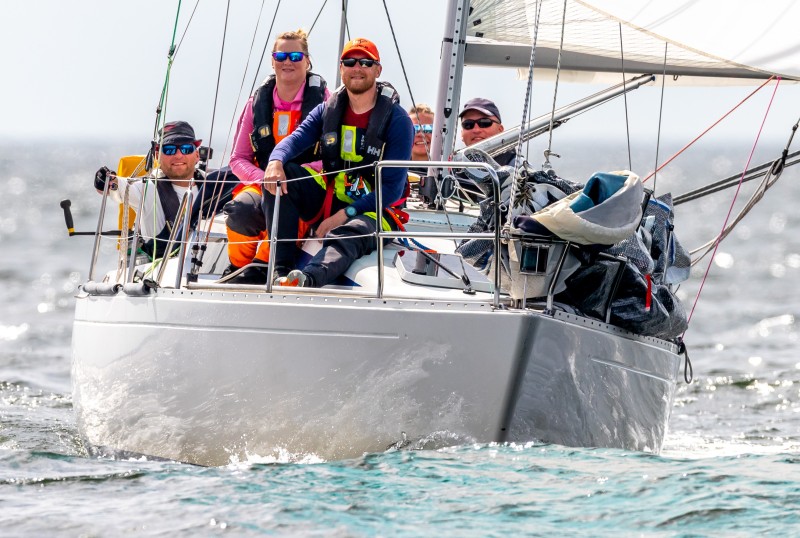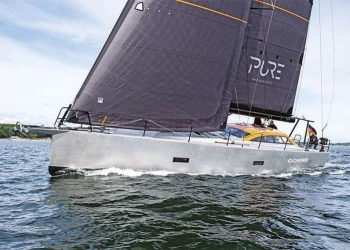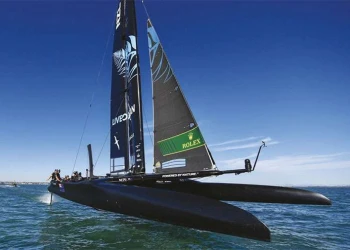
Roschier Baltic Sea Race 2022 ©Pepe Korteniemi
The 600-mile Roschier Baltic Sea Race, racing in the midnight sun
The first edition of the 600-mile Roschier Baltic Sea Race showed just how good the sailing – and racing – can be up here in high summer.
Given the continued success and growing enthusiasm around the globe for 600-mile offshore races it was only a matter of time before demand for one in the Baltic became overwhelming. The biennial Roschier Baltic Sea Race, which first took place in 2022, has all the ingredients of a classic race of this type: a myriad of islands and lighthouses in a region steeped in maritime history, plus a tactically challenging course set on a typically windward-leeward axis that saw the lower-rated boats enjoying 300 miles of downwind sailing to the finish.
Historically most Europeans have tended to head south for their summer breaks and regattas, most often to the Mediterranean. However, the oppressive heatwaves of the past few years demonstrate that this no longer guarantees decent, comfortable weather. By contrast, the Baltic typically offers sunny and settled summer weather, with high-pressure dominating. In July average afternoon temperatures rise comfortably above 20°C, while daily means are a little higher than those of the south coast of the UK, making this region an increasingly attractive destination at the height of summer. Even in heatwaves temperatures rarely exceed 30°C by a large margin.
Like the Mediterranean, the Baltic benefits from a wide variety of countries with rich maritime histories and diverse cultures along its 5,000-mile coastline. Uniquely for a 600-mile race the course is bordered by six different nations: Finland, Sweden, Lithuania, Latvia, Estonia and Russia.
The Roschier Baltic Sea Race is a collaboration between Finland’s Ocean Racing Alliance and the Royal Ocean Racing Club, which brings its unrivalled race management expertise to the event. The first edition benefitted from an explosion of interest in an event of this type, particularly from Finnish, Estonian and Polish sailors, who were joined by teams across the Baltic states and as far away as the UK, Spain and the United States.
Its end of July timing was carefully chosen to maximise the probability of consistent winds. Although competitors therefore miss out on racing just above 60° north at the summer solstice, there’s still almost 20 hours of daylight and astronomical twilight is never reached, making it a magical experience that’s unique in the world of offshore racing.
Seasonal weather norms at this time are for southwesterly winds averaging 8-10 knots, with some lighter sections, but others with stronger breezes. There’s also potential for thermal activity, including squalls, that add to the challenges of the 635-mile course. Land influences, predominantly near the start and finish in the Gulf of Finland, as well as the 73-mile-long Swedish island of Gotland, make it a very strategic race, while the lack of strong tidal streams gives navigators a wide range of routing options.
The first edition saw 213 sailors from 18 nations depart under clear blue skies and a light southerly breeze that filled in as the fleet passed the Helsinki Lighthouse, 12 miles from the start line. While it’s not unusual for offshore races to include a lighthouse as a mark of the course, a unique aspect of this race is that three of them form marks of the course. Helsinki’s is relatively recent, having been constructed in the late 1950s, but Harmaja Lighthouse, on a small islet close to the port has been an important landmark since the 16th century, although a light was not established until 1883.
Almagrundet lighthouse, some 200 miles from the start, stands on a shoal a few miles offshore from the outer islands of the Stockholm archipelago. The current 28-metre high light was built as a remotely operated lighthouse in 1964, replacing two lightships that had operated since the late 19th century.
For the inaugural race the first part of the course favoured the larger and faster boats, with the Volvo 70 I Love Poland reaching Almagrundet after 15 intense hours of racing that included six sail changes. At that point she held a useful 25-minute lead on the water ahead of the Volvo Ocean 65 Ambersail 2. However, the beauty of a race where every class sails the same course under IRC is that any well-sailed and well-prepared boat has the potential to take overall victory.

Around the half-way point Tilmar Hansen’s German TP52 Outsider was in pole position until the HSV youth team on another German competitor, the Carkeek 47 Störtebeker, took the lead after IRC time correction. The largest boat in the race, Kenneth Bjoerklund’s Norwegian CNB 76 Enderpearl, with Ocean Racing Alliance commodore Ari Känsäkoski on board, then became favourite for a period.
In a tightly fought four-way battle on the water that saw the lead change in the fight for line honours multiple times, I Love Poland eventually took the winning gun, just 700 metres ahead of Outsider after 72 hours of racing. Another Volvo 70, HYPR Ocean Racing’s GP Bullhound, took third place on the water, only an hour later, followed shortly afterwards by Ambersail 2.
‘The plan was to fight to the end and it was exactly that. There were a few wind holes but we crossed the line first and we are delighted,’ says Grzegorz Baranowski, skipper of I Love Poland. ‘When I look at the names on this trophy, we are so proud that ours will go with them. I am even more proud of my young crew who are trying their best to go forward.’
Despite the wealth of experience in the fleet, including boats that have successfully competed in multiple Rolex Fastnet Races, RORC Transatlantic Races and Caribbean 600s, overall victory eventually went to a local amateur crew in a very modest vessel.
On the penultimate day the 32ft 1980s Swedish Albin Nova Team Mobline, raced double-handed by Paer Lindfors and Nadine Kugel, took the lead. However, overall victory on IRC eventually went to Helsinki school teacher Salla Kaven’s 32ft H-323 Silver Moon ll, which crossed the finish with a 16 minute advantage ahead of Team Mobline after time correction.
Silver Moon ll has been in Kaven’s family since new in 1985 and was crewed by her family and friends, who sailed an immaculate race. Her team has previously won many local races, but never a major international competition. ‘I was speechless, just so happy, we never thought we could win this race,’ she says. ‘It was great sailing and everything went well, but even when we crossed the line, I didn’t believe it. The message to all the amateur sailors out there is: ‘You can do it if you want to – do what you love!’”

Although two of the lowest rated boats in the fleet topped the podium, the next three places in the overall results went to the big IRC Zero boats. Störtebeker finished just 47 minutes adrift of Mobline after IRC time correction, and 33 minutes ahead of Outsider, while Enderpearl completed the IRC Zero podium. Swede Niclas Heurlin’s Farr 400 Wetjob headed the leaderboard in IRC One, 47 minutes ahead of Arto Linnervuo’s Xp44 Xtra Staerk, which was the first Finnish boat to complete the race.
Early entries for 2024 already include Mobline, Xtra Staerk, Arto Linnervuo’s other boat, the DSS foil-equipped Inifiniti 52 Tulikettu, and Per Roman’s JPK 1180 Garm. Christian Zugel’s well-travelled modified Volvo 70 Tschuss 2 is also on the list, but is far from the biggest boat – at the time of writing that accolade goes to Zachary Lamb’s giant Swan 88 Spiip. Others include a Swan 441 sailed by Raija Alapeteri, Ocean Ladies, a Figaro ll and Hamburgischer Verein Seefahrt’s Judel-Vrolijk 52 Haspa Hamburg. Silver Moon ll is also sure to be there to defend her victory. At the other end of the scale, Niklas Zennström’s state of the art CF520 Ran is also expected to be on the start line.
They are all sure to encounter more intense racing, camaraderie and magical moments in an event that shows every sign of joining the ranks of the best 600-mile races, including the Fastnet, Caribbean 600 and Middle Sea Race.
Entry fees include two days complimentary berthing, both before and after the race, at Helsinki’s Marina Bay, the official guest harbour in the heart of Helsinki, which can accommodate yachts of up to 45m length and five metres in draught. The cosmopolitan waterfront city, located on the tip of a peninsula and an archipelago of more than 300 islands, has one of the highest standards of urban living in the world.
Helsinki is a perfect start or end point for a cruise taking in some of the tens of thousands of islands in the Finnish and Swedish archipelagos. The timing of the Roschier Baltic Sea Race also dovetails neatly with the biggest offshore race in the Baltic, the Gotland Runt, which attracts 300 entries racing from Stockholm on four different courses around the island at the end of June.
The founders of the Ocean Racing Alliance are all hugely experienced offshore racers and there’s significant local political support for the race. Official race supporters include the City of Helsinki; Nyländska Jaktklubben (NJK), Finnish Offshore Racing Association (AMP); Helsingfors Segelklubb (HSK); FINIRC and the Xtra Stærk Ocean Racing Society. It makes for a winning combination alongside the international appeal of RORC races and the club’s proven world class race management expertise.





